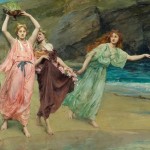by Helen King (monthly contributor)
I was watching Peter Greenaway’s movie The Draughtsman’s Contract (1982) again last week. Set at the end of the seventeenth century, it opens with a series of landed gentry types gossiping, often aiming to shock. After telling them a story from her childhood, one of the beautifully-dressed women states confidently “I used to pee like a horse. I still do.”
If you look up “pee like a horse” or “piss like a horse” you’ll find various statements about just how spectacularly a horse can urinate. But knowing rather too much for my own good about the history of medicine, I started to wonder whether this was all there was to her claim. Greenaway’s women are often pretty highly-sexed individuals and this one is no exception. Perhaps there’s something here about her body being more open, more free, than that of a respectable woman should be.
Peeing like a virgin?
The sixteenth-century physician Laurent Joubert published two collections of what he called “popular errors” – beliefs that were held widely in his native France but which he wants to show are mistaken. One which he reports is the notion that, because she has a narrower urinary channel, a virgin can “piss straight and far” in an “unfettered and clear” manner which is a “beautiful mark of maidenhood”. Is this about quantity, or style? Another is that giving a virgin dock leaves to smell will make her urinate immediately. 
These popular beliefs went back to various medieval medical treatises. De secretis mulierum, once wrongly attributed to Albertus Magnus, is a medieval Latin text which was translated into German and French. It says that virgins’ urine is clear and sparkling, but once they have had sex their urine becomes muddy because it contains blood and sperm. Golden urine is a dangerous sign because it means the virgin is heating up with sexual desire. Why do physicians need to look at urine? Because women can conceal the truth of their sexuality so “a man must turn to their urine”. The writer also states that true virgins will urinate the moment that they smell, not dock leaves, but the fruit of a lettuce.
The gardens of Adonis
Lettuce is an interesting vegetable here. In ancient Greece, at the height of summer, women would plant little pots of seeds of lettuce, wheat, barley and fennel in pots and baskets on their roof-tops in honour of the god Adonis. These “gardens of Adonis” would spring to life quickly in the hot summer sun, but shrivel up and die just as rapidly. The classicist Marcel Detienne saw here an analogy with the life and death of Adonis; sexually precocious, he died before his prime, gored by a boar, his body found in a bed of lettuce. There’s a reference to the rapid growth of the seeds in Shakespeare’s Henry VI Part 1:
Thy promises are like Adonis’ garden/That one day bloomed and fruitful were the next.
The image on the right shows a Victorian painting in which the women hold the gardens of Adonis over their heads as they run to the sea. In this ritual and in the myth behind it, lettuce is highly sexual.
The sound of urine
So is Greenaway’s character revealing her sexual experience, or claiming a lack of it? The movie is not without its classical references. There’s a significant section near the end where the lady of the house retells the story of Hades, Persephone and the pomegranate: symbol of fruitfulness (all those seeds) but also of death, a point graphically made in this scene, when its blood-like juice is squeezed out.
Perhaps that reference to peeing like a horse contains some modern ‘popular error’ that the way a woman urinates reveals her level of sexual experience. And it’s not just the volume: it’s also the sound. Albertus Magnus’ contemporary William of Saliceto says a virgin ‘urinates with a very delicate hiss and indeed takes longer than a boy’ because her body is ‘tighter’ than that of a sexually experienced woman. If a virgin is expected to pee in a delicate way, then Greenaway’s character is certainly not a virgin!
Marcel Detienne (1977) The Gardens of Adonis: Spices in Greek Mythology (Princeton University Press; French original 1972)
